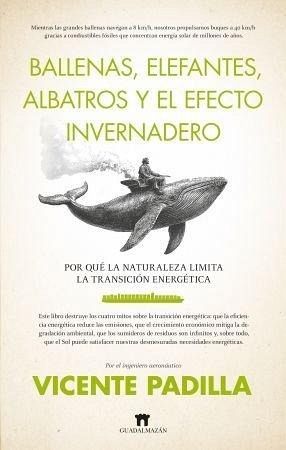
Ballenas, Elefantes, Albatros Y El Efecto Invernadero
Versandkostenfrei!
Erscheint vorauss. 18. November 2025
18,99 €
inkl. MwSt.

PAYBACK Punkte
9 °P sammeln!
It would be enough to capture a tiny fraction of the solar radiation that reaches the Earth to meet all our energy needs. This statement, repeated like a mantra, hides a relentless physical reality: the Sun's energy, although immense, is scattered with a density of 1640 kWh/m² per year, while our civilization demands concentrated energy. Why does photosynthesis only harness 0.08% of the solar energy available after 3.5 billion years of evolution? How is it possible for rich countries to reduce their emissions while global CO₂ continues to rise? Why are our advances in energy efficiency not ...
It would be enough to capture a tiny fraction of the solar radiation that reaches the Earth to meet all our energy needs. This statement, repeated like a mantra, hides a relentless physical reality: the Sun's energy, although immense, is scattered with a density of 1640 kWh/m² per year, while our civilization demands concentrated energy. Why does photosynthesis only harness 0.08% of the solar energy available after 3.5 billion years of evolution? How is it possible for rich countries to reduce their emissions while global CO₂ continues to rise? Why are our advances in energy efficiency not slowing consumption? This book answers these questions not from an ideological standpoint, but from the physical laws that govern energy transformation and the inevitable generation of waste. Using examples from everyday life, the author builds a devastating argument against blind faith in technology as the solution to our environmental problems. After analyzing the amount of energy we would need to recycle all our waste, including CO₂, and the real limits of energy capture through renewables, the book confronts us with an uncomfortable conclusion: our economic model is in direct conflict with the laws of physics, and no innovation can circumvent them. On a planetary scale, the surface area available for solar energy capture, including forests, scrubland, and arid areas such as deserts, is 88 million km². To meet the needs of an equitable world that recycles 100% of its waste, we would need 13 million km²--equivalent to half the African continent--covered with energy capture devices. This book challenges the four fundamental myths that sustain our hopes for the energy transition: that efficiency reduces emissions, that enrichment reduces environmental degradation, that waste sinks are infinite, and, above all, that the Sun can satisfy our excessive energy needs. While the blue whale swims at 8 km/h, adapted to the low energy density available on the planet, humans propel container ships at 40 km/h thanks to fossil fuels that concentrate the solar energy accumulated over millions of years. This difference--1,300 times more energy consumption per unit of biomass than other living beings--exposes the real problem: it is not our technologies, but our energy intensity. Through a relentless analysis based on the laws of physics, this book reveals why, despite 29 climate summits, progress is minimal, and why the only way to maintain our world by transforming material waste into residual heat would require an amount of energy that renewables cannot provide. An enlightening book that mathematically demonstrates why the fallacy of decoupling emissions from growth, the finite capacity of planetary sinks, and the inexorable increase in waste leave us facing a conclusion as inevitable as entropy: we will have to reinvent our relationship with energy before our fossil fuel inheritance runs out.














